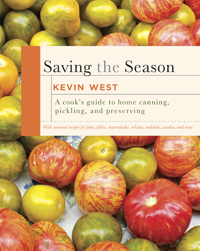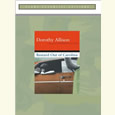Small Batch, Big Taste
Kevin West talks with Chapter 16 about the pleasures of home preserving
Not long ago, on a summer day made for a hammock, a cold drink, and a good book, I found myself standing over a hot stove in my small kitchen, keeping vigil over a magenta, furiously boiling pool of sugar, macerated blackberries, and lemon juice, my wooden spoon on heavy rotation. I had gotten it into my head that I needed to try to canning jam. An hour or so later, in spite of a few minor blunders and my own messiness, I had three lovely, warm half-pints of blackberry jam to show for my efforts.
 My enabler in this lark was Kevin West—or, rather, it was his gorgeous new book, Saving the Season: A Cook’s Guide to Home Canning, Pickling, and Preserving, a seductive guide to seemingly every possible thing you could make from a fruit or vegetable (and more) and then preserve for later. Like the best cookbooks, it need not live in the kitchen, and in fact one may be loathe to let it near a hot stove, lest it be splattered by the boiling jam you never really thought you were industrious enough to make, much less “put up,” as the vernacular has it.
My enabler in this lark was Kevin West—or, rather, it was his gorgeous new book, Saving the Season: A Cook’s Guide to Home Canning, Pickling, and Preserving, a seductive guide to seemingly every possible thing you could make from a fruit or vegetable (and more) and then preserve for later. Like the best cookbooks, it need not live in the kitchen, and in fact one may be loathe to let it near a hot stove, lest it be splattered by the boiling jam you never really thought you were industrious enough to make, much less “put up,” as the vernacular has it.
Saving the Season is an extraordinary achievement, a thing of great beauty and a thorough compendium. Its pages are silky, its photography as ambrosial as the many concoctions West explains how to prepare. Recipes are organized by season; following these four main chapters are appendices listing fruit varieties, peak seasons by region, and the pH ranges of common foods. For the cook who is an avid reader—or if you’re less chef than someone who likes to devour good writing about food—there are bountiful literary treats here, too: poems, snippets from great novels, and brief essays and anecdotes by West. These include everything from a brief history of the Golden Age of Jam to a narrative on digging ramps in West Virginia; from brining basics to a guide for storing garlic; from tips on slicing peaches to a brief history of the Blenheim apricot, Alice Waters’s favorite fruit.
I challenge anyone to spend some time with Saving the Season and not come away determined to put up a few jars of jam or relish or pickles or heirloom tomato sauce. As West argues, it really is doable—and pleasurable. I’ve now set my sights on the alchemy of vinegar and our garden’s bounty of cucumbers: pickles.
 In advance of his appearance at Parnassus Books in Nashville on July 24, Kevin West answered questions from Chapter 16 via email.
In advance of his appearance at Parnassus Books in Nashville on July 24, Kevin West answered questions from Chapter 16 via email.
Chapter 16: Today, as you point out, we don’t suffer seasonal want—the supermarket is always stocked, and gourmet shops offer compelling assortments of small-batch products. So what’s the very best argument for putting up your own?
West: There are so many good reasons for putting up your own food: the thrift of preserving home-grown produce, the pride of self-sufficiency, the ecological benefit of sourcing and processing foodstuffs locally, and the merit of opting out of the industrial food system by supporting nearby farmers and farmers markets. But I would add one more reason to the top of the list: pleasure. I simply like eating homemade preserves best. What could be better than homemade chow chow (relish) made with backyard produce? Or wild blackberry jam? Or pickled ramps that were dug with friends on a bright spring day when the lady’s slippers and columbine were in bloom? Try finding that at the supermarket.
Chapter 16: Though you argue that home canning is “easy, pleasurable, and safe,” many people will have a hard time shaking the notion that canning is a lot of work, not to mention a challenging prospect for those with itty-bitty kitchens. How do you respond when you encounter this skepticism?
West: Two words: small batch. When I first got started preserving, I was foolishly ambitious because I could remember having seen Gran work her way through bushels of produce. I tried to follow suit with twenty pounds of cherries bought at the Santa Monica Farmers Market. The project cost me a fortune and pretty much ruined my weekend—and the quality of the preserves suffered. Plus, how much cherry preserves can one person actually use? I’m not stocking a bomb shelter.
Today I’m much more inclined to put up just a few pounds of something at a time—I can knock off a batch of zucchini pickles or apricot jam in an hour. A small batch will still yield several jars (one to open right away, one to put up, and one to give away). And the project offers a nice little afternoon job on par with, say, making a pie or cake from scratch. Most people won’t do preserving work every day, or even every week. But, as the name of my book suggests, I like to think in terms of the seasons. So I’d suggest putting up a few jars of strawberry jam and pickled asparagus in the spring; canned peaches and dilly beans in summer; apple butter and green tomato relish in the fall; some sauerkraut, candied citrus peel, and marmalade in winter. That’s a manageable amount of work over the course of a year, and a nice array of homemade products to use and share.
Chapter 16: What’s the perfect, fail-proof place for a novice to start with preserving—perhaps one sweet and one savory selection. Assume we’re starting with what’s available at farmer’s markets in Tennessee right now.
West: Two of the best reasons for saving the season are canned tomatoes and canned peaches. Start there: the recipes are easy and the results are surefire. Peaches and tomatoes are everywhere this time of the year, and when winter comes and you open the jars it will be like revisiting the best of summer.
Chapter 16: Your East Tennessee grandparents loom large in the story of how you came to canning and to a deep respect for food culture in general. What’s your favorite memory of enjoying the season’s bounty with them?
West: Papa said there’s only two things that money can’t buy, and that’s true: true love and homegrown tomatoes. Of the many lasting memories I have of Gran and Papa’s farm, none is more vivid than the taste of tomato sandwiches made with his beefsteak tomatoes brought in warm from the garden and still smelling of the vine.
Chapter 16: The photographs in Saving the Season are just gorgeous. Were you already a skilled photographer before you began working on the book? Why was it important for you to handle the art as well as the writing?
West: Thank you. I didn’t have any particular experience as a photographer before I started my blog, Savingtheseason.com. But I had been a staff writer for years at a glossy magazine that was renowned for the quality of its photography, and also I spent many weekends lurking around art museums. So I knew what I wanted the pictures on my blog to look like, and the miracle of cheap digital photography let me keep at it until I more or less figured out how to get the pictures I saw in my mind’s eye.
When it came time to do the book, I decided to take the pictures because there was no other way to have a photographer with me year round at the farmers market, in the kitchen, and on road trips to chase the harvest. I must have shot at a dozen locations in California, as well as in Tennessee, South Carolina, multiple locations in New York, Massachusetts, Oregon, West Virginia, North Carolina, and Louisiana. I just always took a camera with me, and the pictures sort of took care of themselves.
Chapter 16: After disappointing results with your first attempt at strawberry jam, what inspired you to keep going—and going on to become an expert on preservation of all kinds?
West: Well, there is a very long answer to that question, and it probably involves more psycho-babble than anyone wants to hear. I would just say that the book is a tribute to my West grandparents, John and Eloise West from Blount County, Tennessee, and the recipes I developed are expressions of gratitude for the people and the places that shaped me.
But there’s also an easier answer to your question: one weekend I wanted to make jam, and my first attempt was a total flop. So I geeked out and decided to master the art of home canning. Preserving became a hobby, then an obsession, and finally the subject of my first cookbook.
Chapter 16: The literary passages pertaining to preservation and seasonal eating make this book not just a reference for cooking but a real joy to read. Do you have a favorite?
West: I love the poems by living poets, including Seamus Heaney, Donald Hall, Robert Hass, and my friend Dana Goodyear. But at this time of the year, I always get a particular kick out of rereading Pablo Neruda’s “Ode to Tomatoes,” which is a mock-epic that describes salad-making as a royal wedding between the tomato and the onion. The poem is silly and majestic and wonderful—like an old man inventing fairy tales for his grandchildren.
Kevin West will discuss Saving the Season at Parnassus Books on July 24, 2013, at 6:30 pm.





